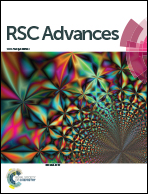Multifunctional hollow polydopamine-based composites (Fe3O4/PDA@Ag) for efficient degradation of organic dyes†
Abstract
As a newly appeared biomimetic platform and universal surface modification agent, polydopamine (PDA) has been paid great attention recently. However, the fabrication of multifunctional hollow PDA-based nanostructures remains a challenge and has been rarely reported. Herein, a facile method to prepare multifunctional hollow Fe3O4/PDA@Ag spherical composites is reported. The in situ embedding of Fe3O4 nanoparticles and the formation of a PDA shell have been achieved in a single system employing carboxylic-capped polystyrene (PS-COOH) spheres as a hard template, which can be selectively dissolved by tetrahydrofuran. Subsequently, silver nanoparticles were anchored on the PDA surface via in situ reduction by the PDA layers, leading to a multifunctional hollow PDA-based composite, i.e., Fe3O4/PDA@Ag. This newly prepared composite could efficiently catalyze the degradation of 4-nitrophenol and rhodamine B with NaBH4 as a reducing agent, and the reaction rate constants were calculated using the pseudo-first-order reaction equation. Compared to non-hollow PS@Fe3O4/PDA@Ag, the hollow composite exhibited an enhanced performance toward both reactions without a significant loss in activity even after ten cycles. This multifunctional hollow PDA-based composite may find potential applications in other domains like heavy metal removal or antibacterial applications.


 Please wait while we load your content...
Please wait while we load your content...